ECO mode MERCEDES-BENZ C-Class 2000 W202 User Guide
[x] Cancel search | Manufacturer: MERCEDES-BENZ, Model Year: 2000, Model line: C-Class, Model: MERCEDES-BENZ C-Class 2000 W202Pages: 130, PDF Size: 2.43 MB
Page 43 of 130
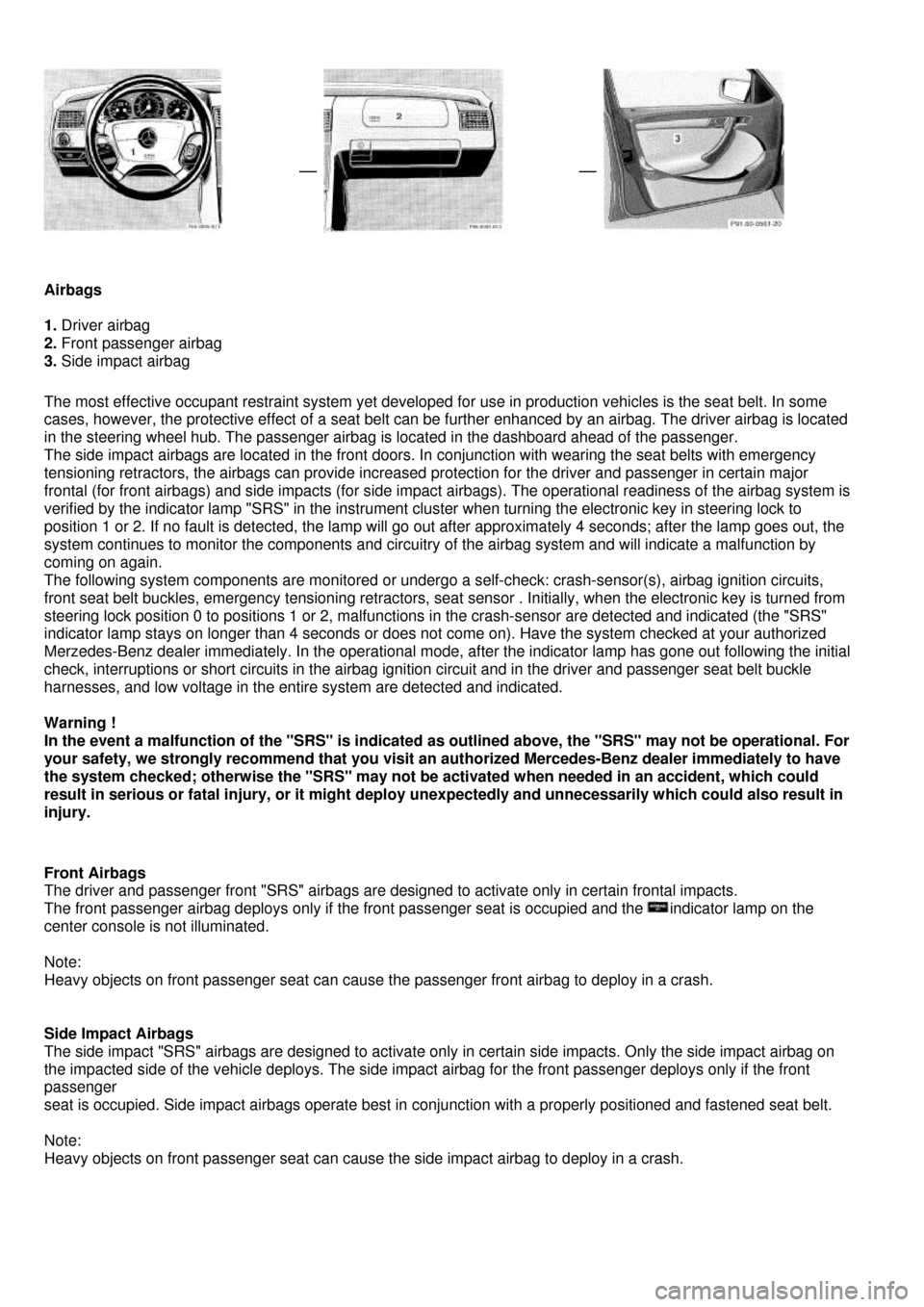
Airbags
1. Driver airbag
2. Front passenger airbag
3. Side impact airbag
The most effective occupant restraint system yet developed for use in production vehicles is the seat belt. In some
cases, however, the protective effect of a seat belt can be further enhanced by an airbag. The driver airbag is located
in the steering wheel hub. The passenger airbag is located in the dashboard ahead of the passenger.
The side impact airbags are located in the front doors. In conjunction with wearing the seat belts with emergency
tensioning retractors, the airbags can provide increased protection for the driver and passenger in certain major
frontal (for front airbags) and side impacts (for side impact airbags). The operational readiness of the airbag system is
verified by the indicator lamp "SRS" in the instrument cluster when turning the electronic key in steering lock to
position 1 or 2. If no fault is detected, the lamp will go out after approximately 4 seconds; after the lamp goes out, the
system continues to monitor the components and circuitry of the airbag system and will indicate a malfunction by
coming on again.
The following system components are monitored or undergo a self-check: crash-sensor(s), airbag ignition circuits,
front seat belt buckles, emergency tensioning retractors, seat sensor . Initially, when the electronic key is turned from
steering lock position 0 to positions 1 or 2, malfunctions in the crash-sensor are detected and indicated (the "SRS"
indicator lamp stays on longer than 4 seconds or does not come on). Have the system checked at your authorized
Merzedes-Benz dealer immediately. In the operational mode, after the indicator lamp has gone out following the initial
check, interruptions or short circuits in the airbag ignition circuit and in the driver and passenger seat belt buckle
harnesses, and low voltage in the entire system are detected and indicated.
Warning !
In the event a malfunction of the "SRS" is indicated as outlined above, the "SRS" may not be operational. For
your safety, we strongly recommend that you visit an authorized Mercedes-Benz dealer immediately to have
the system checked; otherwise the "SRS" may not be activated when needed in an accident, which could
result in serious or fatal injury, or it might deploy unexpectedly and unnecessarily which could also result in
injury.
Front Airbags
The driver and passenger front "SRS" airbags are designed to activate only in certain frontal impacts.
The front passenger airbag deploys only if the front passenger seat is occupied and the indicator lamp on the
center console is not illuminated.
Note:
Heavy objects on front passenger seat can cause the passenger front airbag to deploy in a crash.
Side Impact Airbags
The side impact "SRS" airbags are designed to activate only in certain side impacts. Only the side impact airbag on
the impacted side of the vehicle deploys. The side impact airbag for the front passenger deploys only if the front
passenger
seat is occupied. Side impact airbags operate best in conjunction with a properly positioned and fastened seat belt.
Note:
Heavy objects on front passenger seat can cause the side impact airbag to deploy in a crash.
Page 46 of 130

Infant and Child Restraint Systems
We recommend that all infants and children be properly restrained at all times while the vehicle is in
motion. All lap-shoulder belts except driver seat have special seat belt retractors for secure fastening
of child restraints. To fasten a child restraint, use th is seat belt: Follow child restraint instructions for
routing. Then pull shoulder belt out completely and let it retract. During the seat belt retraction a
ratcheting sound can be heard to indicate that the spec ial seat belt retractor is activated. The belt is
now locked. Push down on child restraint to take up any slack. To deactivate, release seat belt
buckle and let seat belt retract completely. The seat belt can again be used in the usual manner.
Warning !
Never release the seat belt buckle while vehicle is in motion, since the special seat belt
retractor will be deactivated.
Important !
The use of infant or child restraints is required by law in all 50 states and all Canadian provinces.
Infants and small children should be seated in an approp riate infant or child restraint system properly
secured by a lap-shoulder belt, and that complies with U.S. Federal Motor Vehicle Safety Standard
213 and Canadian Motor Vehicle Safety Standard 213. A statement by the child restraint
manufacturer of compliance with this standard ca n be found on the instruction label on the restraint
and in the instruction manual provided with the re straint. When using any infant or child restraint
system, be sure to carefully read and follow all manu facturer's instructions for installation and use.
Please read and observe warning labels affixed to inside of vehicle.
Children 12 years old and under must never ride in the front seat, except in a Mercedes-Benz
authorized BabySmart™ compatible child seat, which operates with the BabySmart™ system
installed in the vehicle to deactivate the passenger side front airbag when it is properly
installed. Otherwise they will be struck by the airbag when it inflates in a crash. If this
happens, serious or fatal injury will result.
According to accident statistics, children are safer when properly restrained in the rear
seating positions than in the front seating positions. Infants and small children must ride in
back seats and be seated in an infant or child restraint system, which is properly secured
with the vehicle's seat belt, fully in accordan ce with the seat manufacturer's instructions.
Infants and small children should never share a seat belt with another occupant. During an
accident, they could be crushed between the occupant and seat belt. Children too big for
child restraint systems must ride in back seats using regular seat belts. Position shoulder
belt across chest and shoulder, not face or neck. A booster seat is necessary to achieve
proper belt positioning for children from 41 Ibs. to the point where a lap/shoulder belt fits
properly without one.
When the child restraint is not in use, remove it from the car or secure it with the seat belt to
prevent the child restraint from becoming a projectile in the event of an accident.
U.S.A. Models only:
Since 1986 all U.S. child restraints comply with U. S. regulations without the use of a tether strap.
Canada Models only: This vehicle is provided with tether anchorages for a top tether strap. Consult
your authorized Mercedes-Benz dealer for installa tion of these anchorages. In compliance with
Canadian Motor Vehicle Safety Standard 210.1, ch ild restraint tether anchorage hardware is
attached to the tool kit located in the trunk.
Page 70 of 130
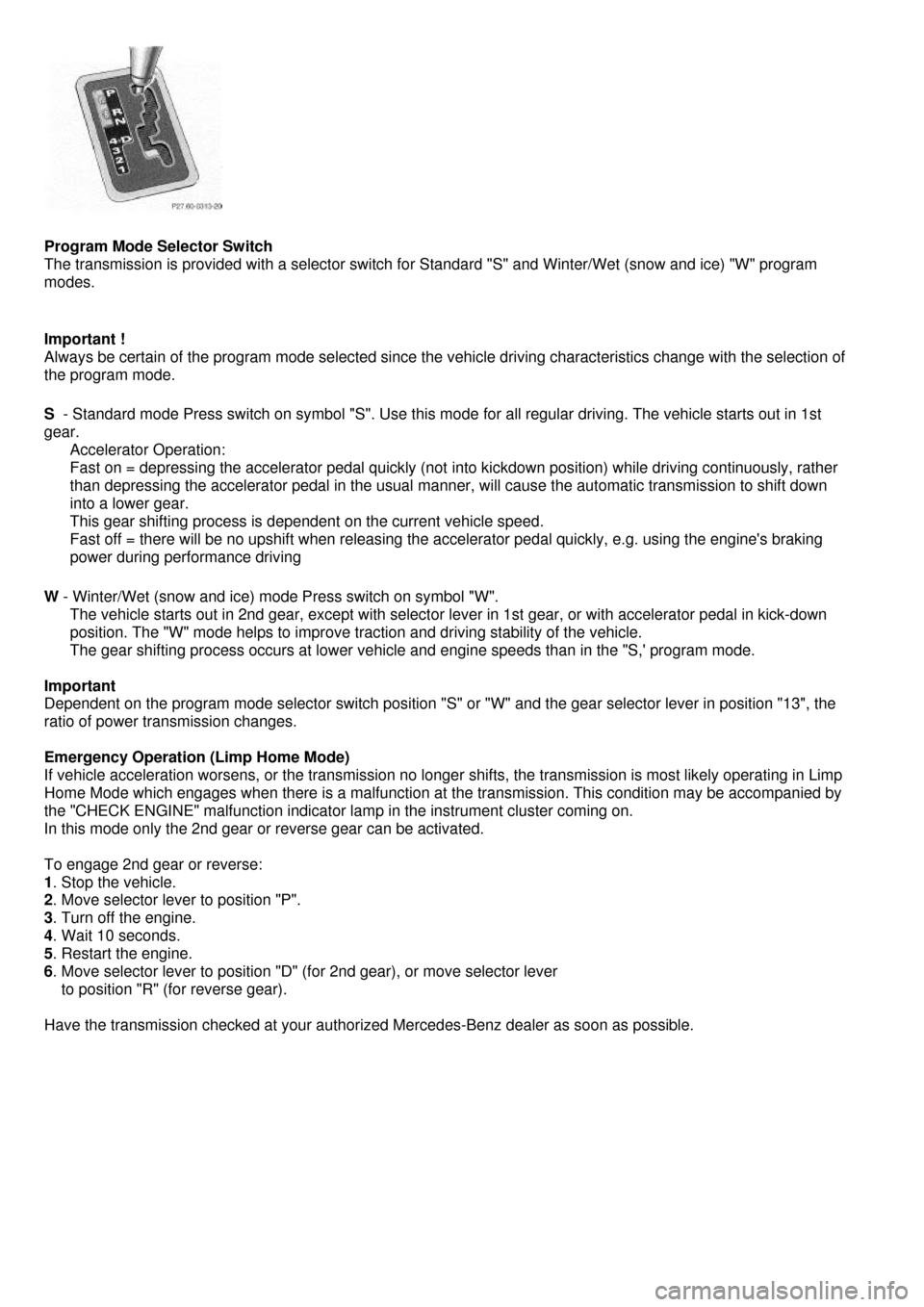
Program Mode Selector Switch
The transmission is provided with a selector switch for Standard "S" and Winter/Wet (snow and ice) "W" program
modes.
Important !
Always be certain of the program mode selected since the vehicle driving characteristics change with the selection of
the program mode.
S - Standard mode Press switch on symbol "S". Use this mode for all regular driving. The vehicle starts out in 1st
gear.
Accelerator Operation:
Fast on = depressing the accelerator pedal quickly (not into kickdown position) while driving continuously, rather
than depressing the accelerator pedal in the usual manner, will cause the automatic transmission to shift down
into a lower gear.
This gear shifting process is dependent on the current vehicle speed.
Fast off = there will be no upshift when releasing the accelerator pedal quickly, e.g. using the engine's braking
power during performance driving
W - Winter/Wet (snow and ice) mode Press switch on symbol "W".
The vehicle starts out in 2nd gear, except with selector lever in 1st gear, or with accelerator pedal in kick-down
position. The "W" mode helps to improve traction and driving stability of the vehicle.
The gear shifting process occurs at lower vehicle and engine speeds than in the "S,' program mode.
Important
Dependent on the program mode selector switch position "S" or "W" and the gear selector lever in position "13", the
ratio of power transmission changes.
Emergency Operation (Limp Home Mode)
If vehicle acceleration worsens, or the transmission no longer shifts, the transmission is most likely operating in Limp
Home Mode which engages when there is a malfunction at the transmission. This condition may be accompanied by
the "CHECK ENGINE" malfunction indicator lamp in the instrument cluster coming on.
In this mode only the 2nd gear or reverse gear can be activated.
To engage 2nd gear or reverse:
1. Stop the vehicle.
2. Move selector lever to position "P".
3. Turn off the engine.
4. Wait 10 seconds.
5. Restart the engine.
6. Move selector lever to position "D" (for 2nd gear), or move selector lever
to position "R" (for reverse gear).
Have the transmission checked at your authorized Mercedes-Benz dealer as soon as possible.
Page 77 of 130
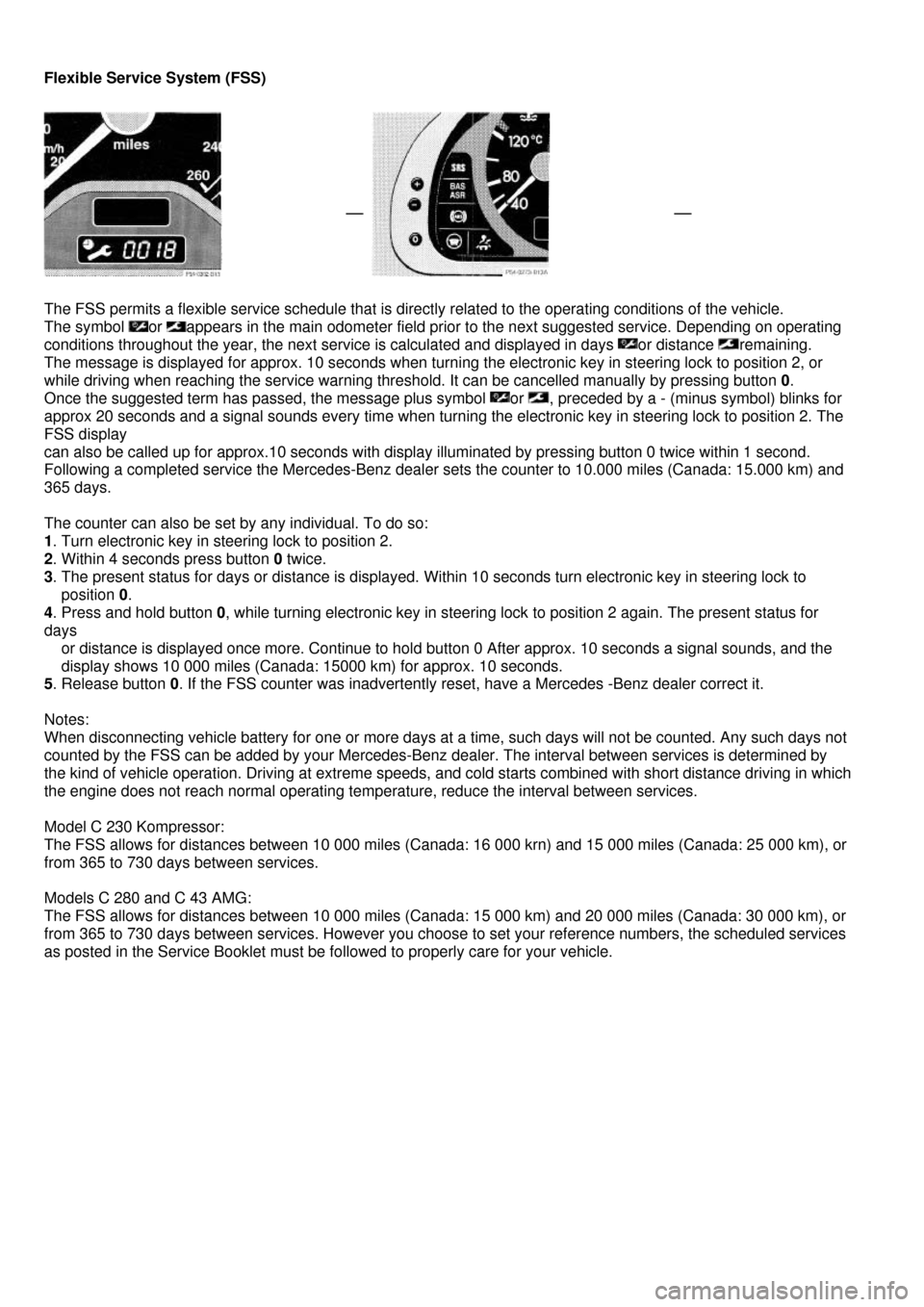
Flexible Service System (FSS)
The FSS permits a flexible service schedule that is directly related to the operating conditions of the vehicle.
The symbol or appears in the main odometer field prior to the next suggested service. Depending on operating
conditions throughout the year, the next service is calculated and displayed in days or distance remaining.
The message is displayed for approx. 10 seconds when turning the electronic key in steering lock to position 2, or
while driving when reaching the service warning threshold. It can be cancelled manually by pressing button 0.
Once the suggested term has passed, the message plus symbol or , preceded by a - (minus symbol) blinks for
approx 20 seconds and a signal sounds every time when turning the electronic key in steering lock to position 2. The
FSS display
can also be called up for approx.10 seconds with display illuminated by pressing button 0 twice within 1 second.
Following a completed service the Mercedes-Benz dealer sets the counter to 10.000 miles (Canada: 15.000 km) and
365 days.
The counter can also be set by any individual. To do so:
1. Turn electronic key in steering lock to position 2.
2. Within 4 seconds press button 0 twice.
3. The present status for days or distance is displayed. Within 10 seconds turn electronic key in steering lock to
position 0.
4. Press and hold button 0, while turning electronic key in steering lock to position 2 again. The present status for
days
or distance is displayed once more. Continue to hold button 0 After approx. 10 seconds a signal sounds, and the
display shows 10 000 miles (Canada: 15000 km) for approx. 10 seconds.
5. Release button 0. If the FSS counter was inadvertently reset, have a Mercedes -Benz dealer correct it.
Notes:
When disconnecting vehicle battery for one or more days at a time, such days will not be counted. Any such days not
counted by the FSS can be added by your Mercedes-Benz dealer. The interval between services is determined by
the kind of vehicle operation. Driving at extreme speeds, and cold starts combined with short distance driving in which
the engine does not reach normal operating temperature, reduce the interval between services.
Model C 230 Kompressor:
The FSS allows for distances between 10 000 miles (Canada: 16 000 krn) and 15 000 miles (Canada: 25 000 km), or
from 365 to 730 days between services.
Models C 280 and C 43 AMG:
The FSS allows for distances between 10 000 miles (Canada: 15 000 km) and 20 000 miles (Canada: 30 000 km), or
from 365 to 730 days between services. However you choose to set your reference numbers, the scheduled services
as posted in the Service Booklet must be followed to properly care for your vehicle.
Page 84 of 130

Winter Driving
Have your car winterized at your authorized Mercedes-Benz dealer before the onset of winter.
• Change the engine oil if the engine contains an oil which is not approved for winter operation.
For viscosity (SAE/CCMC class) and filling quantity, see Capacities: Fuels, Coolants,
Lubricants etc. in Index.
• Check engine coolant anticorr osion/antifreeze concentration.
• Additive for the windshield washer and headl amp cleaning system: Add MB Concentrate "S"
to a premixed windshield washer solvent/ant ifreeze which is formulated for below freezing
temperatures (see Index).
• Test battery: Battery capacity drops with dec reasing ambient temperature. A well charged
battery helps to ensure that the engine can be started, even at low ambient temperatures.
• Tires: We recommend M+S rated radial-ply tires on all four wheels for the winter season.
Observe permissible maximum speed for M+S rated radial-ply tires and the legal speed limit.
Note:
In winter operation, the maximum effectiveness of the Antilock Brake System (ABS), Acceleration Slip Regulation
(ASR) or the Electronic Stab ility Program (ESP) can only be achieved with M+S rated radial-ply tires and/or snow
chains recommended by Mercedes-Benz. Snow chains maximize performance.
Snow Chains
Use only snow chains that are tested and recommended by Mercedes-Benz. Your authorized Mercedes-Benz
dealer will be glad to advise you on this subject. Ch ains should only be used on the rear wheels.
Follow the manufacturer's mounting instructions. Snow ch ains should only be driven on snow covered roads at
speeds not to exceed 30 mph (50 km/h). Remove chains as soon as possible when driving on roads without snow.
For tips on driving on slippery winter roads, refer to In dex. Vehicles with Acceleration Slip Regulation (ASR) or
Electronic Stability Program (ESP): When driving with snow chains, press the ASR or ESP control switch, refer to
Index.
Model C 43 AMG
Important !
Use of snow chains is permissible only on winter tire size 215/45 R 17 H M+S. Refer to "Rims - Tires" in section
"Technical Data" (see Index).
Travelling Abroad
Abroad, there is a widely-spread Mercedes-Benz service network at your disposal. If you plan to travel into areas
which are not listed in the index of your dealer directory, you should request pertinent information from your
authorized Mercedes-Benz dealer.
Page 88 of 130

Odometer Display Field
(Models C 280 and C 43 AMG)
Turn electronic key in steering lock to position 2 and wait until the symbols and appears in the
odometer display field. Within 1 second press button 0 twice.
The following messages are available:
"OK"
"-1.0 Q" (Canada: -1.0 L)
"-1.5 Q" (Canada: -1.5L)
"-2.0 Q" (Canada: -2.0 L)
If the message "-2.0 Q" (Canada: -2.0 L) blinks and a signal sounds, add oil to upper (max) mark of the dipstick.
"HI"
The message "Hi" blinks and a signal sounds.
Do not overfill the engine.
Excessive oil must be drained or siphoned. It could cause damage to engine and catalytic converter not covered
by the Mercedes-Benz Limited Warranty.
The symbol flashes in the odometer field if a proper oil level check cannot be performed. The oil level check
can be repeated after a short while. Perform the oil level check with the dipstick, if it cannot be completed via the
odometer display field. In this case we recommend that you have the system checked at a Mercedes-Benz dealer.
Notes:
If the symbols and are continuously illuminated after pressing button 0 twice and there is no change in the
odometer display field or the low engine oil level warning lamp comes on, a malfunction has occurred to the system .
Perform the engine oil level check with the dipstick. If no oil leaks are noted continue to drive to the nearest
Mercedes-Benz dealer to have the system checked.
Automatic Transmission Fluid Level
The transmission has a permanent fill of automatic transmission fluid. Regular automatic transmission fluid
level checks and changes are not required. For this reason the dipstick is omitted. If you notice fluid leaks or
gear shifting malfunctions, have your authorized Mercedes-Benz dealer check the transmission fluid level.
Page 92 of 130

Wheels
Replace rims or tires with the same designation, manufacturer and type as shown on the original part. See your
authorized Mercedes-Benz dealer for further information. See your authorized Mercedes-Benz dealer for information
on tested and recommended rims and tires for summer and wi nter operation. They can also offer advice concerning
tire service and purchase.
Tire Replacement
Front tires should be replaced in sets. Rims and tires must be of the correct size and type. For dimensions, see
"Technical Data". We recommend that you break in new ti res for approx. 60 miles (100 km) at moderate speed. It is
imperative that the wheel mounting bolts be fastened to a tightening torque of 80 ft.lb. (110 Nm) whenever wheels are
mounted. For rim and tire specifications, refer to "Technical Data".
Warning !
Worn, old tires can cause accidents. If the tire tread is badly worn, or if the tires have sustained damage, replace
them. When replacing rirns, use only genuine Mercedes-Benz w heel bolts specified for the particular rim type. Failure
to do so can result in the bolts loosening and possibly an accident.
Rotating Wheels
Rotation of wheels with summer tires does not apply to m odel C 43 AMG. The wheels can be rotated according to the
degree of tire wear while retaining the same direction of travel. Rotating, however, should be carried out at the
scheduled service intervals, before the characteristic tire wear pattern (shoulder wear on front wheels and tread
center wear on rear wheels) becomes visible, as otherwise the driving properties deteriorate.
Important !
Unidirectional tires must always be mounted with arrow on tire sidewall pointing in direction of vehicle forward
movement.
Notes:
Thoroughly clean the inner side of the wheels any time you rotate the wheels or wash the vehicle underside. The use
of retread tires is not recommended. Retread tires may adversely affect the handling charac teristics and safety of the
vehicle. Dented or bent rims can caus e tire pressure loss and damage to the tire beads. For this reason, check rims
for damage at regular intervals. The rim flanges must be checked for wear before a tire is mounted. Remove burrs, if
any. Check and ensure proper tire inflation pressure after rotating the wheels. For Tire Inflation Pressure refer to
Index.
Spare Wheel (except C 43 AMG)
Important !
The spare wheel rim is mounted with a full size tire of the same type as on the vehicle, and is fully functional.
However, that spare wheel rim is weight optimized an d has a limited service life of 12 000 miles (20 000 km) use
before a standard wheel rim must replace it. In the case of a flat tire, you may temporarily use the spare wheel. Do
not operate vehicle with more than one spare wheel mounted.
Unidirectional tires must always be mounted with arrow on tire sidewall pointing in direction of vehicle forward
movement. If the arrow on tire side wall does not point in direction of vehicle forward movement when using the spare
wheel, observe the following restrictions:
• Drive to the nearest tire repair facility as soon as possible.
For rim and tire specifications, refer to "Technical Data".
Warning !
The spare wheel rim is for temporary use only. Use for over a total of 12 000 miles
(20 000 km) may cause wheel rim failure leading to an accident and possible injuries.
Page 104 of 130
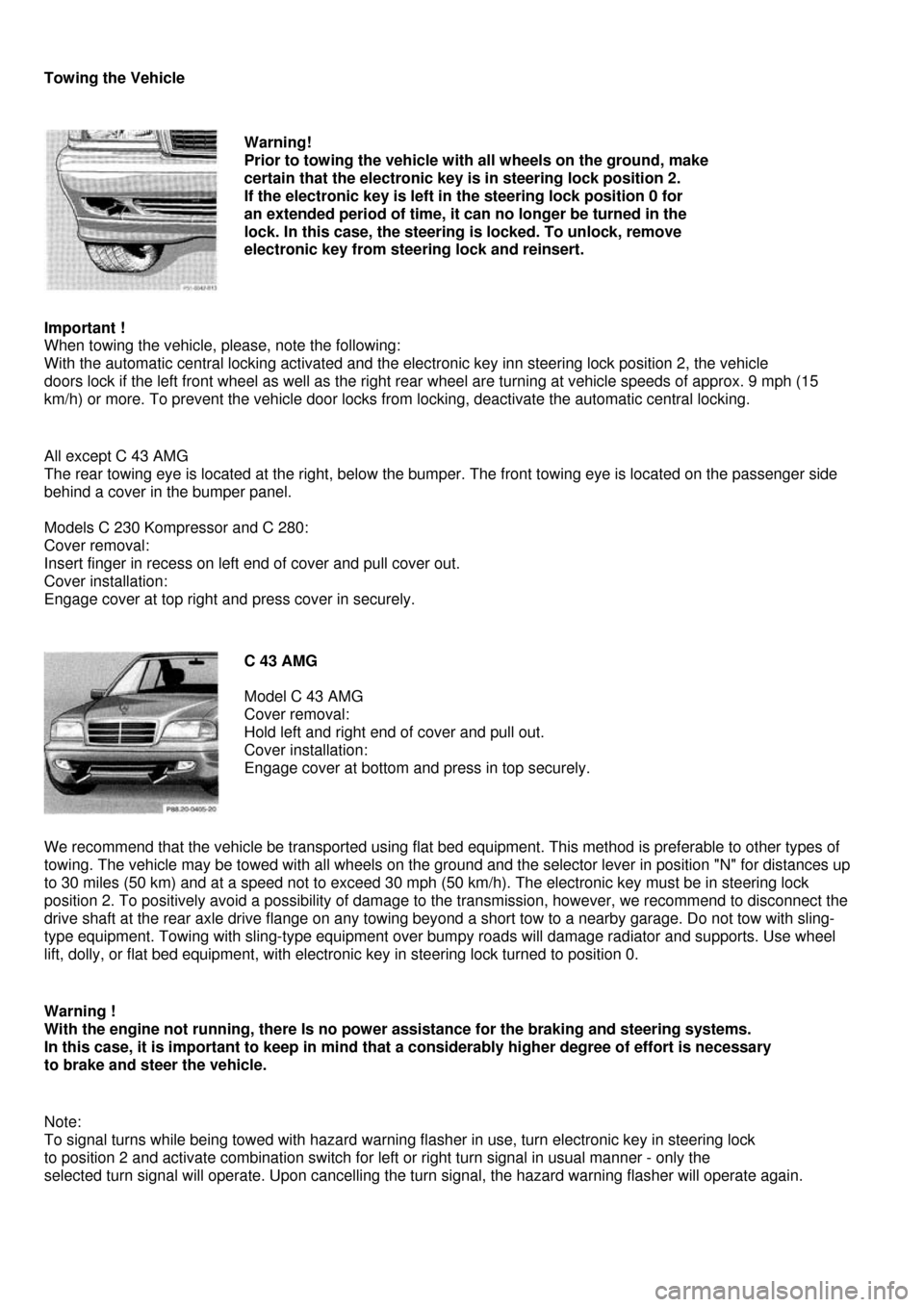
Towing the Vehicle
Warning!
Prior to towing the vehicle with all wheels on the ground, make
certain that the electronic key is in steering lock position 2.
If the electronic key is left in the steering lock position 0 for
an extended period of time, it can no longer be turned in the
lock. In this case, the steering is locked. To unlock, remove
electronic key from steering lock and reinsert.
Important !
When towing the vehicle, please, note the following:
With the automatic central locking activated and the electronic key inn steering lock position 2, the vehicle
doors lock if the left front wheel as well as the right rear wheel are turning at vehicle speeds of approx. 9 mph (15
km/h) or more. To prevent the vehicle door locks from locking, deactivate the automatic central locking.
All except C 43 AMG
The rear towing eye is located at the right, below the bumper. The front towing eye is located on the passenger side
behind a cover in the bumper panel.
Models C 230 Kompressor and C 280:
Cover removal:
Insert finger in recess on left end of cover and pull cover out.
Cover installation:
Engage cover at top right and press cover in securely.
C 43 AMG
Model C 43 AMG
Cover removal:
Hold left and right end of cover and pull out.
Cover installation:
Engage cover at bottom and press in top securely.
We recommend that the vehicle be transported using flat bed equipment. This method is preferable to other types of
towing. The vehicle may be towed with all wheels on the ground and the selector lever in position "N" for distances up
to 30 miles (50 km) and at a speed not to exceed 30 mph (50 km/h). The electronic key must be in steering lock
position 2. To positively avoid a possibility of damage to the transmission, however, we recommend to disconnect the
drive shaft at the rear axle drive flange on any towing beyond a short tow to a nearby garage. Do not tow with sling-
type equipment. Towing with sling-type equipment over bumpy roads will damage radiator and supports. Use wheel
lift, dolly, or flat bed equipment, with electronic key in steering lock turned to position 0.
Warning !
With the engine not running, there Is no power assistance for the braking and steering systems.
In this case, it is important to keep in mind that a considerably higher degree of effort is necessary
to brake and steer the vehicle.
Note:
To signal turns while being towed with hazard warning flasher in use, turn electronic key in steering lock
to position 2 and activate combination switch for left or right turn signal in usual manner - only the
selected turn signal will operate. Upon cancelling the turn signal, the hazard warning flasher will operate again.
Page 122 of 130
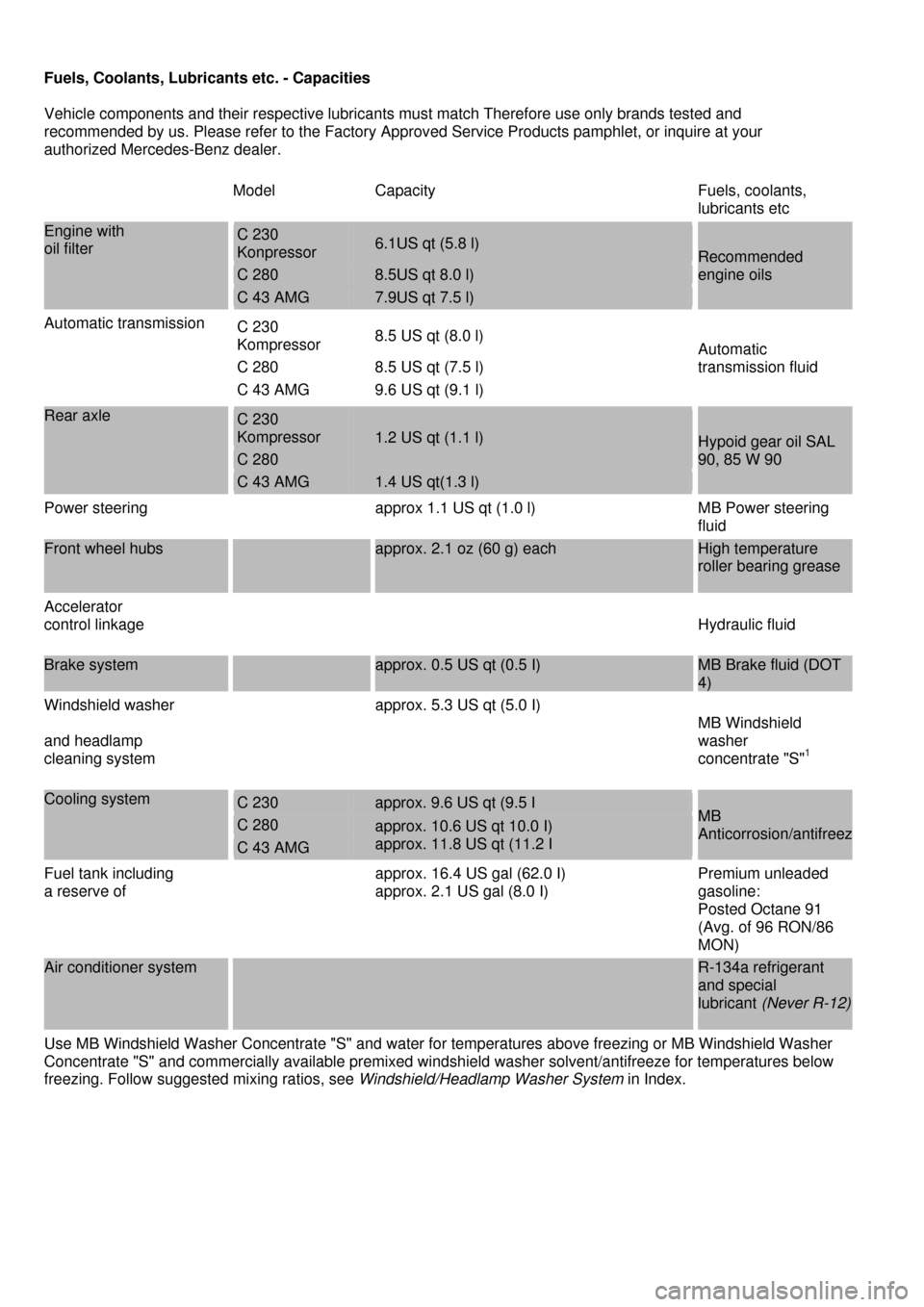
Fuels, Coolants, Lubricants etc. - Capacities
Vehicle components and their respective lubricants must match Therefore use only brands tested and
recommended by us. Please refer to the Factory Approv ed Service Products pamphlet, or inquire at your
authorized Mercedes-Benz dealer.
Model Capacity Fuels, coolants,
lubricants etc
Engine with
oil filter C 230
Konpressor 6.1US qt (5.8 l)
C 280 8.5US qt 8.0 l)
C 43 AMG 7.9US qt 7.5 l)
Recommended
engine oils
Automatic transmission C 230
Kompressor 8.5 US qt (8.0 l)
C 280 8.5 US qt (7.5 l)
C 43 AMG 9.6 US qt (9.1 l)
Automatic
transmission fluid
Rear axle C 230
Kompressor
C 280
1.2 US qt (1.1 l)
C 43 AMG 1.4 US qt(1.3 l)
Hypoid gear oil SAL
90, 85 W 90
Power steering approx 1.1 US qt (1.0 l) MB Power steering
fluid
Front wheel hubs
approx. 2.1 oz (60 g) each High temperature
roller bearing grease
Accelerator
control linkage
Hydraulic fluid
Brake system approx. 0.5 US qt (0.5 I) MB Brake fluid (DOT
4)
Windshield washer
and headlamp
cleaning system
approx. 5.3 US qt (5.0 I)
MB Windshield
washer
concentrate "S"
1
Cooling system C 230 approx. 9.6 US qt (9.5 I
C 280
C 43 AMG
approx. 10.6 US qt 10.0 I)
approx. 11.8 US qt (11.2 I
MB
Anticorrosion/antifreez
Fuel tank including
a reserve of
approx. 16.4 US gal (62.0 I)
approx. 2.1 US gal (8.0 I) Premium unleaded
gasoline:
Posted Octane 91
(Avg. of 96 RON/86
MON)
Air conditioner system
R-134a refrigerant
and special
lubricant (Never R-12)
Use MB Windshield Washer Concentrate "S" and water for temperatures above freezing or MB Windshield Washer
Concentrate "S" and commercially available premixed windsh ield washer solvent/antifreeze for temperatures below
freezing. Follow suggested mixing ratios, see Windshield/Headlamp Washer System in Index.
Page 125 of 130

Coolants
The engine coolant is a mixture of water and anticorrosion/antifreeze, which provides:
• corrosion protection,
• freeze protection,
• boiling protection (by increasing the boiling point).
The cooling system was filled at the factory with a coolant providing freeze protection to approx. -22°F
(-30°C) and corrosion protection. The coolant solution must be used year round to provide the
necessary corrosion protection and increase in the boil-over protection. You should have it replaced
every 3 years. To provide the important corrosion protection, the solution must be at least 45%
anticorrosion/antifreeze (equals a freeze protection to approx. -22°F [-30°C]). If you use a solution
that is more than 55% anticorrosion/antifreeze (freeze protection to approx. -49°F [-45°C]), the engine
temperature will increase due to the lower heat transfer capability of the solution. Therefore, do not
use more than this amount of anticorrosion/antifreeze. If the coolant level is low, water and MB
anticorrosion/antifreeze should be used to bring it up to the proper level (have cooling system
checked for signs of leakage). The water in the cooling system must meet minimum requirements,
which are usually satisfied by normal drinking water. If you are not sure about the water quality,
consult your authorized Mercedes-Benz dealer.
Anticorrosion/antifreeze
Your vehicle contains a number of aluminum parts. The use of aluminum components in motor
vehicle engines necessitates that anticorrosion/antifreeze coolant used in such engines be specifically
formulated to protect the aluminum parts. (Failure to use such anticorrosion/antifreeze coolant will
result in a significantly shortened service life.)
Therefore the following product is strongly recommended for use in your car: Mercedes-Benz
Anticorrosion/Antifreeze Agent. Before the start of the winter season (or once a year in the hot
southern regions), you should have the anticorrosion/antifreeze concentration checked. The coolant is
also regularly checked each time you bring your vehicle to your authorized Mercedes-Benz dealer for
service.
Model Approx.freeze Protection
-35°F
(~37°C)
-49°F
(-45°C)
C 230 Kompressor 5.0 US qt
(4.75 I)
5.5 US qt
(5.25 I)
C 280 5.3 US qt
(5.0 I)
5.8 US qt
(5.5 I)
C 43 AMG 5.9US qt
(5.6 I)
6.6 US qt
(6.2 I)